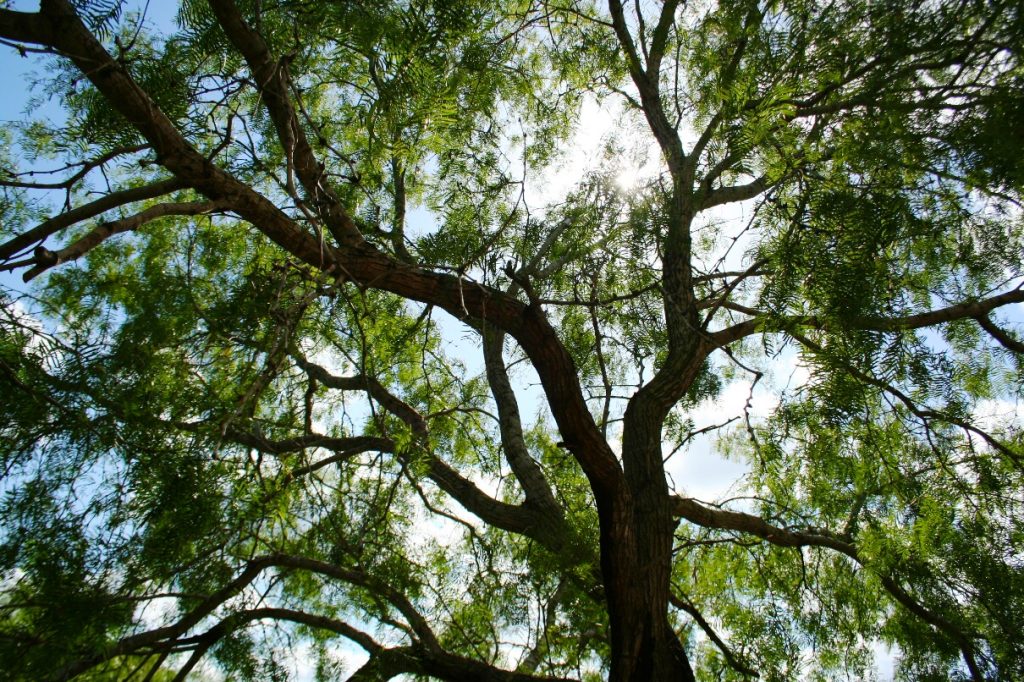Well known for being a sought after flavor in high-end restaurants and barbecue pits alike, mesquite is the common name for several varieties of trees found in the desert southwest. This iconic tree has provided shelter and food to wildlife and humans for centuries and is comprised of three common species: honey mesquite (Prosopis glandulosa), screwbean mesquite (Prosopis pubescens ), and velvet mesquite (Prosopis velutina).
The mesquite ranges from 2-15 feet tall with the honey and velvet mesquites topping out at 60 feet. The tree has lateral roots that grow well beyond the canopy and a tap root that can go as deep as 200 feet. These extensive root systems are also the home to colonies of nitrogen-fixing bacteria which enrich the soil and support plant germination and growth. If the tree is chopped off, the roots can regenerate and start growing a new trunk.
Mesquite wood is known for its density and durability. Native Americans used the tree’s thorns to make sewing needles and stripped the inner bark to make cloth and baskets. Although the branches are crooked and twisted, they were used by early settlers to construct Spanish missions, haciendas, and even fencing. Today, artisans use the mesquite’s white and red wood to craft furniture, flooring, and sculptures.
Mesquite wood is also valued for the flavor it adds to smoked food. You can also replicate this flavor by adding dried seed pods to your cooking fire or grill.
The mesquite’s limbs can have multiple or single stems which give each tree its own distinctive shape. Smaller branches have thorns, and each branch produces leaves with two or more secondary veins that in turn have two rows of leaflets. In the spring, the leaflets bear five-petaled yellow or light green flowers. The flowers, called “catkins,” are rich sources of pollen and nectar for wildlife.
Although the mesquite is a tree, it is a member of the legume family. When fertilized, these flowers create small green fruits that look like pea pods.
Large quantities of the bean pods can be collected each summer and stored for year-round use. The seed pod can be ground into flour for cakes and bread.
Mesquite beans, which can still germinate after 40 years of dormancy, are a treasured food source of protein, carbohydrates, and calcium with four tablespoons of mesquite meal providing approximately 70 calories. The beans can be ground into flour, roasted and substituted for coffee, boiled and eaten like other beans.
The beans, which vary in flavor from tree to tree, have hints of vanilla, cinnamon, or lemon. Mesquite beans can be boiled and eaten as is, or simmered over low heat until soft, reserving the liquid for a sweet broth or as a base for mesquite jelly. In a pinch, settlers would roast the beans to create a coffee substitute.
Mesquites are also used for their medicinal properties. Native Americans and early settlers made a tea from mesquite bark or roots to cure diarrhea. Roots would also be boiled to create a balm to heal minor wounds. Crushed mesquite leaves, mixed with water and urine, were believed to cure headaches. (we’ll take their word for it on that one)
In the spring, broken branches or cuts to the mesquite’s bark causes sap to run. This thick liquid falls to the ground and hardens to the consistency of sticky, hard candy. Mesquite gum can be eaten like candy, chewed like gum, or even used as a lozenge to provide relief for sore throats.
If you have access to mesquite beans, you can make the perfect summer drink. Mix two parts water to one part mesquite seed pods and add a cinnamon stick or two. Bring the mixture to a boil and then reduce the heat and let simmer for two hours.
Remove from heat and let the brew sit overnight.
The next morning, pour the mixture through a strainer and discard the solids. Chill and serve over ice for a refreshing and exotic mesquite iced tea.
